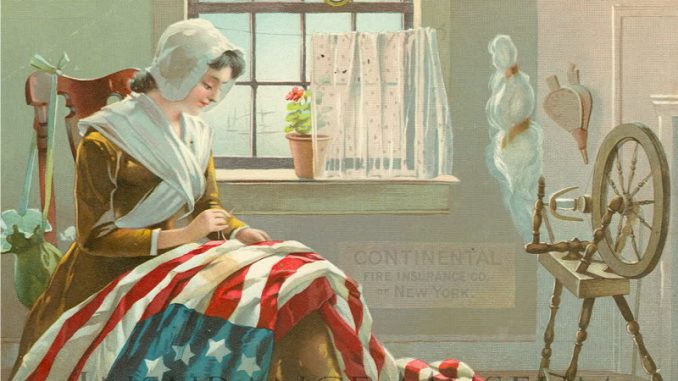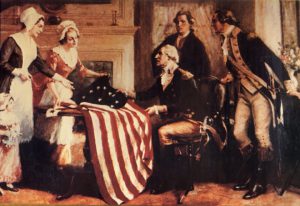
Betsy Ross…In Her Words
A glimpse into the life of Betsy Ross, using her words as she may have spoken them, to tell her story…
I am Betsy Ross.
Over the last several hundred years, it seems you may have forgotten what happened in the making of our nation’s flag so long ago. Here is my story and that of our flag…
I was born Elizabeth Griscom on January 1, 1752. My father was Samual Grisom, a carpenter, like Jesus’ dad, Joseph, and my mom was Rebecca James Grisom. I had 17 brothers and sisters. We went to a Quaker school nearby. The Quakers are called “Friends”. When I became old enough, I learned to be an upholsterer and was apprenticed to William Webster(3). Along the way, I met and fell in love with a young man named John Ross.
On a November night in 1773, I eloped with the love of my life, John Ross. My friends, the Quakers, “read me out” of the church. That is, they kicked me out, because of my elopement. But their decision was okay with me, because I was with my John Ross.
My Married Life
John and I decided to open an upholstery business. We could not count on the Quakers’ business, the only people I knew(4). So this was a big chance that we took together. Since we could not go to the Quaker meetings I used to attend, we started attending Christ Church. Sometimes General Washington attended, too, and even sat in a nearby pew(4).
As the war loomed, getting proper upholstery fabrics became harder and harder(4). John joined the Pennsylvania militia leaving me to carry the business. But he was killed while guarding an ammunition dump. I thought my life would end. An additional hardship for me was that, in my time women, just did not operate a business, but I continued the upholstery business John and I started anyway.
After my time of mourning ended, I continued my business and eventually met and married a sea captain, Joseph Ashburn.
Joseph went to war at sea and I continued to operate our upholstery business.
Tensions Increase Between America and the British
Perhaps you need to understand a little more to follow what happened next? Let me explain…
The British made a law that they could decide to house their soldiers in private homes. They assigned British soldiers to live with me. In the meantime, my dear husband, Joseph, was captured and imprisoned by the British (4). You can likely imagine how difficult it was to be housing British soldiers, when my husband was imprisoned by the British and we and many of our friends so opposed how the British treated us.
This all happened in about the same time period when Thomas Paine wrote “Common Sense”. (If you haven’t read it yet, you should, the arguments he states are timeless and the future of our new little nation is reasoned on what he wrote in that book.). And, what came to pass in the next months shaped a new nation dedicated to freedom.
The Story Unfolds
As our country emerged as a free nation and faced the battles for that freedom, the need for a flag for our new nation became apparent.
As an upholster, I was also hired to do sewing before, during and after the war. For example, I routinely sewed General Washington’s buttons on for him. When a committee was created to create a flag, my uncle, George Ross, was one of the men on that flag creation committee(1). General Washington had sometimes hinted he wanted me to make a flag for our nation when he encountered me at our church(2).
The Design
Because of General Washington and my uncle, I became part of the discussion about our nation’s flag. We all discussed what the flag should look like. The General suggested each state be represented by a star, a six-pointed start. He even suggested the stars be in a circle, because, he noted, circles never end, so no one state’s star would be at the beginning or end. It was further suggested the stars needed to stand out on a dark background. A nice dark blue, like the night sky, was proposed. But my practical side prompted me to suggest making a five-pointed star, which would would be more efficient and economical to sew. So Washington agreed to a five-pointed star.
The British flag was red and white and since we were growing from the British Empire, we thought it might be nice to have the rest of our flag remind everyone from where we came. So our flag included red and white stripes. There are 7 red stripes and 6 white stripes, 13 in all. These stripes were done to represent the 13 original colonies and the stars to represent the 13 states.
Personal Turmoil in the Midst of Turmoil
As I recall, I made the first Union Flag during the summer of 1776. As I mentioned, the British occupied my house in 1777. Their soldiers sat right where I had the material to make the flag, can you even imagine? They did not know that, but I knew and my stomach clenched every time they were in that room. But I had to act like there was no problem and everything was fine.
More Flags
I was asked to make many flags for our new little nation(4). I made flags for our army and navy and many others. If you have any doubts, these agencies kept records of what they paid. Over time, as our nation progressed, I was needed to make many national flags.
Our National Respect
Did you know that in battle, our flag was not permitted to touch the ground? If our flag touched the ground, that flag was considered as not fit to represent our nation anymore. If our flag bearer became wounded or killed, someone nearby would quickly take the flag and hold it high! Many of our brave men died to make sure our flag never touched the ground.
I sometimes cry as I think about those who are keeping and caring for our flag. Keeping our flag is a matter of honor and respect. I have known many men who would kill anyone who disrespected our flag. Such disrespect is dishonoring our flag, our soldiers, our nation and our way of life. These are the ideals we men and women of the Revolution fought and died to establish. Yes, many women died fighting the British, perhaps you should talk with them, too? Thank you for listening to this brief recount of my story and that of the formation of our national flag, which I love. -Betsy Ross
Editor’s Note:
Historians have come to disagree about the story of Betsy Ross. Some believe Ross is actually several different women with stories combined in the story of Betsy Ross. Ross’ descendants were the main source of historical information about Betsy Ross. Additional recorded history about the many women and men, who served in numerous support capacities, is rare and difficult to find. The story of Betsy Ross is still told to represent her or the several women, whose combined efforts are told in the story of Betsy Ross.
Sources:
(3) https://www.history.com/topics/american-revolution/betsy-ross
(1) & (2) http://www.ushistory.org/betsy/
(4) http://www.ushistory.org/betsy/flaglife.html


Leave a Reply